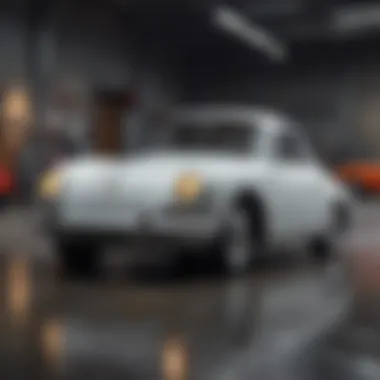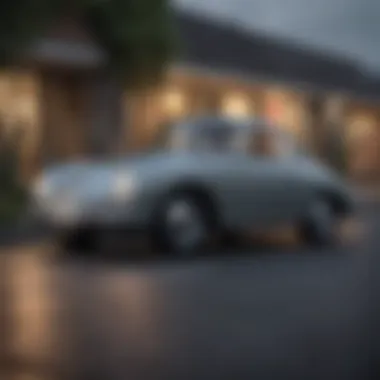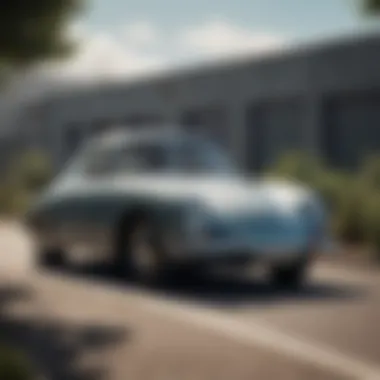Valuing the 1963 Porsche 356B: Market Insights Revealed


Intro
The valuation of the 1963 Porsche 356B is a topic rich with intricacies, appealing to both seasoned collectors and new automotive enthusiasts. Understanding the countless factors affecting the price of this classic car requires careful examination. Historical significance, market bots, car condition, and subsequent trends all weave together a narrative that brings this car’s value to life.
Exploring this theme does more than just reveal numeric values; it unpacks what these metrics mean to collectors and everyday drivers alike. This insight is crucial for informed buying decisions and accurately evaluating investment opportunities. Mentions of iconic designs, adrenaline-inducing drives, and the emotional experience attached to owning such a vehicle will recur throughout the discussion. Recommended maintenance, buying guidance, and an analysis of technological influences are also crucial components of this narrative.
As we press onward, we will delve into the detailed sections, each focusing on a different facet of the Porsche 356B, ensuring a thorough understanding of what shapes its worth today.
In-Depth Car Reviews
Overview of the Vehicle
The Porsche 356B, produced between 1960 and 1963, signified a pivotal transition within the Porsche lineage. Known for its distinct streamlined shape and lightweight construction, it remains one of the most beloved models among enthusiasts. This car laid down the bedrock for Porsche’s subsequent designs, making it a significant piece in automotive history.
Key Specifications
Despite its relatively modest size by today’s standards, the 356B was well-equipped for performance. The car typically housed a 1.6-liter four-cylinder engine, capable of delivering 60 to 75 horsepower. Weighing around 2,100 pounds, this car excelled in agility and responsiveness compared to its formidable competitors of that era.
Performance Analysis
On the road, the Porsche 356B provides an exhilarating experience. From sharp corner handling to quick acceleration, even limited power ignites thrilling drives. Given the vehicle's rear engine placement, striking a better weight-to-power balance adds to both speed and stability.
Interior and Exterior Design
The design aesthetic of the 356B remains timeless. Externally, its clean lines and understated elegance still captivate onlookers. The interior is equally intelligent in layout with minimalist control designs that add to usability. Original pieces, however, play a significant role in determining the overall value during any subsequent dealings.
Safety Ratings and Features
For its time, the Porsche 356B offered commendable safety features, including a robust frame and dependable braking systems with front disc brakes. Though safety standards favored today are much higher, knowing how far this car has evolved might assist potential buyers in assessing its standing.
Historical Background of the Porsche 356B
Understanding the historical context of the 1963 Porsche 356B is crucial for grasping its current market value. The significance of this model extends beyond its engineering merits to its impact on the automotive industry and culture. By analyzing its inception, design evolution, and the broader appreciation for classic cars, enthusiasts can appreciate why the Porsche 356B has garnered persistent interest over the decades.
Prelims to the Porsche 356B
The Porsche 356B was officially launched in 1960 as an update to the original 356 model. Designed by Ferdinand “Butzi” Porsche, it soon gathered positive reception.
Notably, it featured significant carryovers such as a lightweight body and reliable mechanics but it presented tweaked aesthetics and improved performance factors. This model retained the unmistakable Porsche line while promoting daylight efficiency with new larger windows. At its core was the typical rear-engine layout seen in most Porsches, establishing itself within the compact sports car category.
By combining sleek lines with fine engineering and agile handling, the 356B carved out a reputation that led to a solid following among sports car enthusiasts.
Development and Design Changes
The 1963 Porsche 356B reflected several key design changes that set it apart from its predecessors. Firstly, a major alteration was the introduction of larger bumpers—improvements that enhanced both style and functionality.


Moreover, halogen headlights were added, which upgraded visibility and modernized design standards for that era. These decisions predictably influenced consumer sentiments, as driver safety became a developing concern in automotive design.
Additionally, a shift in engine options improved the vehicle’s performance. The 1963 model was available with a 1.6-liter engine generating 75 horsepower or opt-a 95 hp Super engine, boasting unmatched acceleration techniques for its class. This motivated a growing popularity in races and motorsports as owners sought speed incarnate without sacrificing everyday usability.
Cultural Impact and Recognition
The cultural resonance of the Porsche 356B is also noteworthy. They become symbols of the freer-spirited 1960s, representing not only automotive innovation but lifestyle aspirations.
In various films, the 356B ventured beyond the track into mainstream media. Its appearances in cinema contributed to its status as an icon within popular culture. When its silhouette graced the big screen, it showcased a world of excitement and adventure. Many enthusiasts cite the model as a beautiful piece in collections, preferred by connoisseurs who value craftsmanship.
Ultimately, the legacy of the 356B laid a reliable foundation for Porsche, impacting future models profoundly and helped establish the brand as a legend in sportscar history.
Market Trends and Value Assessment
Understanding the nature of market trends is critical for evaluating the value of the 1963 Porsche 356B. The classic car market can exhibit various features that reflect consumer interest, rarity, and desirability of individual models, with the 356B standing as a notable example. In this section, we will pick apart the elements that drive these market dynamics.
Current Market Trends for Classic Cars
Today, the classic car market is experiencing a notable resurgence. More collectors and enthusiasts are engaged with vintage models, leading to escalating values. Enthusiasts are looking for vehicles with design excellence, superior engineering, as well as historical relevance. Other vital factors fueling the growth of this segment include:
- Increased accessibility of information via the internet.
- Climate change concerns encouraging meaningful travel.
- Technology improving restorations and evaluations.
- The allure of investment potential tying into nostalgia.
Literature suggests ongoing interest by younger demographics, further benefiting the market. Millennials are starting to appreciate authenticity and vintage aesthetics alongside traditional collectors. 엔 ti-styling positions of vehicles carry new charm to them that more recent models lack.
Factors Affecting the Value of the Porsche 356B
The valuation process of the 1963 Porsche 356B is influenced by multiple aspects. These concerns include:
- Condition: Restoration quality, wear-and-tear, and originality play crucial roles.
- History: Provenance details, previous ownership, and any notable events impact desirability.
- Rarity: Limited production numbers and specific special editions uptick unique value.
- Current Demand: General interest across demographics further sways prices.
- Market Cycles: Economic conditions influence retro investments solidly. It’s essential buyers watch beyond just aesthetics.
Keeping these factors in focus can direct interested parties toward sensible investment directions.
Historical Sales Data Analysis
By analyzing historical sales records for the 1963 Porsche 356B, recent trends can be observed. In the last decade, notable auction results have consistently indicated high interest levels and competition actions.
To illustrate:
- Top-tier condition 356Bs often breach the $150,000 mark in auctions.
- A shift towards more privated sales has increased the of-market interactions.
- Death in hybrid proceeds has not cratered demand, affecting future valuations positively.
Tracking fluctuations remains pertinent for capturing deeper understanding relating trends to altering values.
Comparative Values with Other Models
All valuable vehicles should have performance parameters openly analyzed. Comparing the 1963 Porsche 356B with contemporaries yields insight. For example, models like the Jaguar E-Type have also solidified similarly high placements in collector culture.
Key differences among these vehicles might include:


- Design philosophy.
- Performance specifications timely upgrades — increasing potential uniqueness.
- Each car's relationships with iconic milestones or movie history impact notoriety further.
These distinctions directly relate to collector mental; thus, naturally, valuations flexibilty rise.
Condition and Its Influence on Value
The condition of a vehicle serves as a fundamental aspect in understanding its market value. Specifically for the 1963 Porsche 356B, the state of the car can affect every detail of its sellability and ultimate return on investment. Buyers are often aware that a vehicle in excellent condition draws a higher price. Conversely, those in poor condition can deter enthusiasts and collectors alike, impacting negotiations and overall desirability.
Assessing a car's condition encompasses various factors including appearance, mechanical function, and the structural integrity of the vehicle. Every aspect contributes temporarily to the purchase price but also to the longer-term value of the car in the evolving classic car market. A well-maintained Porsche 356B certainly stands out in this regard. While rarity and brand history contribute to demand, the condition elevates or diminishes value by defining the car's appeal.
Being well-informed about the condition factors can deeply influence a potential buyer's outlook and ultimate decision. Therefore, understanding these elements regarding the 1963 Porsche 356B is vital for both current owners and investors seeking to enter this market.
Factors Influencing Car Condition Rating
Different elements influence the condition rating of the Porsche 356B. Assessments should ideally consider:
- Exterior Quality: Scratches, dents, paint condition, and the presence of rust can affect perception. A clean and flawless outer structure often increases desirability.
- Interior Condition: Upholstery quality, dashboard functionality, and the overall look of the interior spaces play crucial roles. Well-kept interiors usually attract buyers.
- Mechanical Aspects: Engine functionality, transmission smoothness, and sound suspension contribute greatly. Proper functioning mechanical systems instill confidence.
- Documentation of Work: Evidence of previous maintenance or restoration helps in deducing if the car has been cherished or neglected. Clear records provide prior owners' attention reflected in the vehicle's history.
It's not just about visual inspection; a thorough evaluation is prime to determine what future value could be emerged.
Restoration Impact on Market Value
Restoration of a classic car can greatly influence its market price, including the 1963 Porsche 356B. Various factors include the quality and extent of the restoration, as well as the authenticity of parts used during this process. If performed correctly, restoration works can elevate or dictate the perception of the car's condition in the market. Nevertheless, potentially harmful restoration tactics can quite easily lessen value.
- Quality of Restoration: A professional-grade restoration leads to higher value. Conversely, subpar work can negatively influence demand.
- Originality Factors: Classic car enthusiasts often favor cars that maintain their original parts. Restoring the vehicle with aftermarket components can detract from authenticity, impacting resale values.
- Proven Records of Restoration: Providing documentation of the restoration process can enhance value as it assures buyers of the work's legitimacy. Selling a well-documented restoration often commands higher prices.
Ultimately, restoration should set a pathway for the car that praises its value while preserving its essence.
Documentation and Provenance Importance
A thorough chronicle of a car's life enhances its market value and desirability. Documenting each aspect such as past ownership, repair records, and retaining pertinent information can shape buyers' perceptions significantly. Buyers often appreciate evidence that tells the story of the Porsche 356B; they want reassurance regarding investment.
Key documentation elements include:
- Service History: Records of serviced parts and repairs reveal how well the vehicle has been maintained over time.
- Previous Ownership: Notable owners or a reputable history can elevate buyer interest.
- Detailed Inspections: Comprehensive inventories of inspection can figure prominently during buying decisions, defining if the car has issues or if it has always been impeccable.
- Restoration Details: Information on prior restorations should accompany the servicing records. Having prominent mechanics or firms tied to the restoration process can strengthen valuation worth.
In summary, preserving documentation pays off, as it enriches the story behind the vehicle, ensuring a strong mark in the collector community access and providing insight into true worth.
Enthusiast Community and Collector Demand
The dynamics of the enthusiast community and collector demand substantially influence the value of the 1963 Porsche 356B. Enthusiasts come together due to their shared admiration for operational and historical significance of automobiles like the 356B. The collective passion often translates into robust support for preserving such vehicles, ultimately adding to their worth in the marketplace.
An essential aspect lies in the network of car shows and auctions. These events provide the platform for enthusiasts to showcase their restorations, share knowledge, and connect with potential buyers. During such occasions, the presence of iconic cars becomes a spectacle. Shared admiration can elevate desirability, pushing values to noteworthy realms. Often, buyers who attend these events seek specific models that speak to their personal experiences or aspirations. Creating bonds over these shared interests significantly raises the cultural stakes tied to the Porsche 356B, thus reflecting positively on its valuation.
Collectors usually conduct thorough research before making a purchase, assessing not only the carn but also market movement and cultural relevance. This involvement leads to informed offer prices and a better understanding of how the community perceives value. The insights garnered often redefine what defines a classic car, especially for models like the Porsche 356B. Investors are sure in their understanding that a strong community corresponds to heightened demand.


The role of social media today can’t be overstated. Social platforms facilitate direct dialogue between enthusiasts and collectors. Values for classic cars change frequently based on trends within this virtual interaction. Almost instantly, those interested in the market can gauge opinions and advice via sites such as reddit.com or groups on facebook.com.
Collective sentiment is incredibly important in shaping both demand and valuation.incrementgestures like showcasing incoupling support mechanisms create cycles steering prices upward, separating sought commodities from more common platforms.
“A classic is more than nuts, bolts, and metal; it is the pulse of community.”
In summary, the enthusiast community serves as both a catalyst for appreciation as well as a critical leg of the valuation framework for cars like the 1963 Porsche 356B. Recognition, commitment, and discussion surrounding these classics augment their appeal long beyond their production years.
Future Projections for the Porsche 356B
The future of the 1963 Porsche 356B remains an intriguing subject to consider. Given its historical significance and cultural value, understanding future projections can help both enthusiasts and investors navigate potential shifts in value. Changes in the automotive landscape may influence this classic vehicle's desirability, especially as more drivers become interested in classic cars.
Market Predictions and Trends
Presently, many experts suggest a bullish trend for classic cars in the upcoming years. The Porsche 356B stands out in this market due to its renowned heritage. Factors contributing to this projection include an increasing interest in vintage automobiles and a potential rise in disposable incomes among buyers. As the younger generation begins to buy collector cars, the allure of iconic models like the 356B could enhance their value.
Recent auction performances have shown that numbers are frequently higher than before, indicating a growing market. Therefore, it might not be surprising if strong demand persists in the near future.
Technological Advancements Impacting Valuation
Much of today's automotive advancements contrast sharply with classic models. However, this doesn't negate the value of the Porsche 356B. In fact, advancements in technology may also affect market perceptions. As cars become more technologically complex, many drivers seek out simpler, classic alternatives. This trend could present the 356B as an appealing option.
Furthermore, modern monitoring technologies enhance the ability to maintain and record vehicle history. This allows collectors to purchase with more confidence. New tools and apps for classic car owners help facilitate restoration and care. This increased attention on upkeep predicts not only longevity but also greater future value.
Sustainability and Collectibility of Classic Cars
The push towards sustainability increasingly influences purchasing decisions. More consumers are recognizing the importance of preserving classic vehicles as a means to honor automotive heritage. Supporting environmentally-friendly practices can increase the 356B's value.
Buyers could see the longevity of classic cars as a sustainable choice, resulting in higher demand. Additionally, electric vehicle trends might alert prospective enthusiasts to seek out classic models before they become rarer.
Ultimately, the 1963 Porsche 356B appears to have a promising future as market conditions evolve. Understanding these future projections will help discerning enthusiasts and investors align their interests with potential trends as they unfold. Keep watch on market shifts; they might just enhance the allure and fall hand-in-hand with the rising collectibility of this classic car.
Finale: Navigating the Value Landscape
Evaluating the worth of the 1963 Porsche 356B requires nuanced understanding. Various interconnected elements form the framework of its value. Discussions about history, condition, and trends inform best how we gauge worth in a continuously changing market.
This lingering interest in classic cars opens interesting possibilities for investors and collectors alike. As with any automotive investment, one must do due diligence. Knowledge and awareness can enhance potential return on investment long term.
"The true value of a classic car lies not just in its price tag but also in its story and condition."
Summary of Key Insights
Throughout this article, several insights emerge. The 1963 Porsche 356B possesses unique historical significance. It shaped performance vehicles' future and had cultural influence. Market data shows stable trends and the fascination collectors have towards this model.
In general, classic car enthusiasts assess value based not solely on sale prices, but on passion, history, and the emotional connection to the car. Features affecting value are numerous:
- Restored versions usually yield higher prices.
- Originality and service records add to desirability.
- Enthusiast demand contributes to shifting market conditions.
Final Thoughts on Investment Potential
In sum, investment in a 1963 Porsche 356B signifies not just monetary commitment. It's a way to embrace automotive history and culture. For car lovers, the emotional connection to such models can't be overstated. Collectibility of classic automobiles emphasizes preservation alongside appreciation.
New cohorts of collectors arriving make the market attractive still. Moderate predictions suggest any well-maintained models retain value significantly. Careful evaluation of authenticity, modification history, and condition bolster assurance of smart allocation of resources. Simply, the allure remains.



